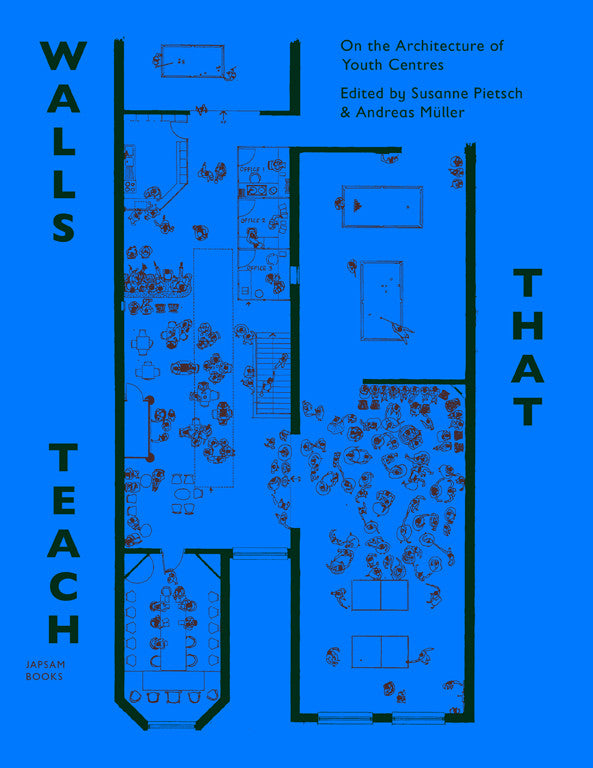Your cart is currently empty!
Architecture
Walls that teach
+++On the Architecture of Youth Centres+++
+++Susanne Pietsch, Andreas Mueller (eds.)+++
978-94-90322-42-7
Sandra Kassenaar / David Bennewith (Colophon)
264
27,5 x 21 cm
Paperback
Published in co-operation and with the support of the Faculty of Architecture, Delft University of Technology
855 grms
English
Translators: Julienne Peeters-Huybrechts, Cornelia Durka
Release date: Winter 2014
Awarded with the DAM ARCHITECTURAL BOOK AWARD 2015
Awarded Best Dutch Book Design 2015
“In this house the walls will teach” declared the Soviet news agency Pravda at the inauguration of the Moscow Palace of Young Pioneers in 1962. This statement casually formulates a recurring motif in the history of architecture for youth: the claim to educate through the built environment. Young people were considered ideal targets for this approach of social constructivism due to their ambivalent status as objects of social rights but not yet subjects of political rights. The organisation of youth centres around leisure time activities partially concealed their educational goals and consequently made them all the more pervasive. The pedagogical power of their architecture is found not only in design but also in modes of using, appropriating and inhabiting them.
Containing 14 essays and 25 case studies, this book traces the manifestations of the idea of pedagogical architecture of youth centres throughout the 20th century.
With contributions by
Susanne Pietsch and Andreas Mueller (editors/introduction), Tom Avermaete, Marina van den Bergen, Dolf Broekhuizen, Peter Blundell Jones, Matthias Donath, Jennifer Mack, Marco di Nallo, Susan Reid, Sue Robertson, Piet Vollaard
About the editors
Andreas Mueller works as an architect in Berlin. He is founder and co-publisher of the magazine An Architektur and was teaching Urban Design at HafenCity University Hamburg. Present he is Professor for exhibition design at the Karlsruhe University of Arts and Design.Within the Kooperative für Darstellungspolitik he designs exhibitions and display concepts for public spaces.
Susanne Pietsch is trained as an interior architect and architect. Her practice is based in Rotterdam. She has taught at Trier University of Applied Sciences and the University of Buenos Aires, where she also conducted research on the spatial effects of self-organized social and cultural institutions on the public domain. Since 2006 she has been engaged at the Architecture Faculty of the TU Delft as a teacher and coordinator in the Chair of the Architecture of the Interior.
On the Architecture of Youth Centres
€34.00
Walls that teach
On the Architecture of Youth Centres
€34.00
Architecture / Awarded / Theory
978-94-90322-42-7
Sandra Kassenaar / David Bennewith (Colophon)
264
27,5 x 21 cm
Paperback
Published in co-operation and with the support of the Faculty of Architecture, Delft University of Technology
855 grms
English
Translators: Julienne Peeters-Huybrechts, Cornelia Durka
Release date: Winter 2014
Awarded with the DAM ARCHITECTURAL BOOK AWARD 2015
Awarded Best Dutch Book Design 2015
“In this house the walls will teach” declared the Soviet news agency Pravda at the inauguration of the Moscow Palace of Young Pioneers in 1962. This statement casually formulates a recurring motif in the history of architecture for youth: the claim to educate through the built environment. Young people were considered ideal targets for this approach of social constructivism due to their ambivalent status as objects of social rights but not yet subjects of political rights. The organisation of youth centres around leisure time activities partially concealed their educational goals and consequently made them all the more pervasive. The pedagogical power of their architecture is found not only in design but also in modes of using, appropriating and inhabiting them.
Containing 14 essays and 25 case studies, this book traces the manifestations of the idea of pedagogical architecture of youth centres throughout the 20th century.
With contributions by
Susanne Pietsch and Andreas Mueller (editors/introduction), Tom Avermaete, Marina van den Bergen, Dolf Broekhuizen, Peter Blundell Jones, Matthias Donath, Jennifer Mack, Marco di Nallo, Susan Reid, Sue Robertson, Piet Vollaard
About the editors
Andreas Mueller works as an architect in Berlin. He is founder and co-publisher of the magazine An Architektur and was teaching Urban Design at HafenCity University Hamburg. Present he is Professor for exhibition design at the Karlsruhe University of Arts and Design.Within the Kooperative für Darstellungspolitik he designs exhibitions and display concepts for public spaces.
Susanne Pietsch is trained as an interior architect and architect. Her practice is based in Rotterdam. She has taught at Trier University of Applied Sciences and the University of Buenos Aires, where she also conducted research on the spatial effects of self-organized social and cultural institutions on the public domain. Since 2006 she has been engaged at the Architecture Faculty of the TU Delft as a teacher and coordinator in the Chair of the Architecture of the Interior.






